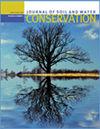Understanding farmers’ adoption of conservation tillage in South Dakota: A modified application of the theory of planned behavior
IF 2.6
4区 农林科学
Q2 ECOLOGY
引用次数: 0
Abstract
The government and stakeholders in the US agricultural sector promote conservation farming practices, but voluntary adoption is still a challenge among agricultural producers at the farm level. This paper aims to investigate the factors that influence the adoption of conservation tillage (CT) among producers in eastern and central South Dakota. A modified application of the theory of planned behavior (TPB) including controls for socioeconomic and demographic indicators is used to understand farmers’ current usage of CT. Data were gathered from a probability sample of 486 commodity crop farming operations through an online and mail survey. We find that the three constructs of the TPB—attitude, subjective norms, and perceived behavioral control—are positively and significantly correlated with the adoption of CT. Binary logistic regression models also show that attitude and perceived behavioral control are related to farmers’ likelihood of adopting CT. Farm size and farmers’ level of education were also positively associated with CT adoption. The results indicate that a modified application of the TPB is useful for understanding the behavior of farmers regarding conservation practices, specifically the adoption of CT in South Dakota. This study contributes to knowledge regarding the role of social-psychological factors in farmers’ CT adoption and provides insights for policymakers and conservation practitioners promoting the adoption of CT in the region.了解南达科他州农民采用保护性耕作的情况:计划行为理论的修正应用
美国政府和农业部门的利益相关者提倡保护性耕作实践,但农业生产者在农场层面自愿采用保护性耕作仍是一项挑战。本文旨在调查影响南达科他州东部和中部生产者采用保护性耕作(CT)的因素。本文对计划行为理论(TPB)进行了修改,包括对社会经济和人口指标的控制,以了解农民目前使用保护性耕作的情况。通过在线和邮寄调查,我们从 486 个商品作物种植基地的概率样本中收集了数据。我们发现,TPB 的三个构件--态度、主观规范和感知行为控制--与 CT 的采用呈显著正相关。二元逻辑回归模型也表明,态度和感知行为控制与农民采用 CT 的可能性有关。农场规模和农民受教育程度也与采用 CT 呈正相关。结果表明,修改后的 TPB 应用有助于了解农民在保护措施方面的行为,特别是南达科他州采用 CT 的情况。这项研究有助于了解社会心理因素在农民采用 CT 过程中的作用,并为政策制定者和保护工作者在该地区推广采用 CT 提供启示。
本文章由计算机程序翻译,如有差异,请以英文原文为准。
求助全文
约1分钟内获得全文
求助全文
来源期刊
CiteScore
4.10
自引率
2.60%
发文量
0
审稿时长
3.3 months
期刊介绍:
The Journal of Soil and Water Conservation (JSWC) is a multidisciplinary journal of natural resource conservation research, practice, policy, and perspectives. The journal has two sections: the A Section containing various departments and features, and the Research Section containing peer-reviewed research papers.

 求助内容:
求助内容: 应助结果提醒方式:
应助结果提醒方式:


